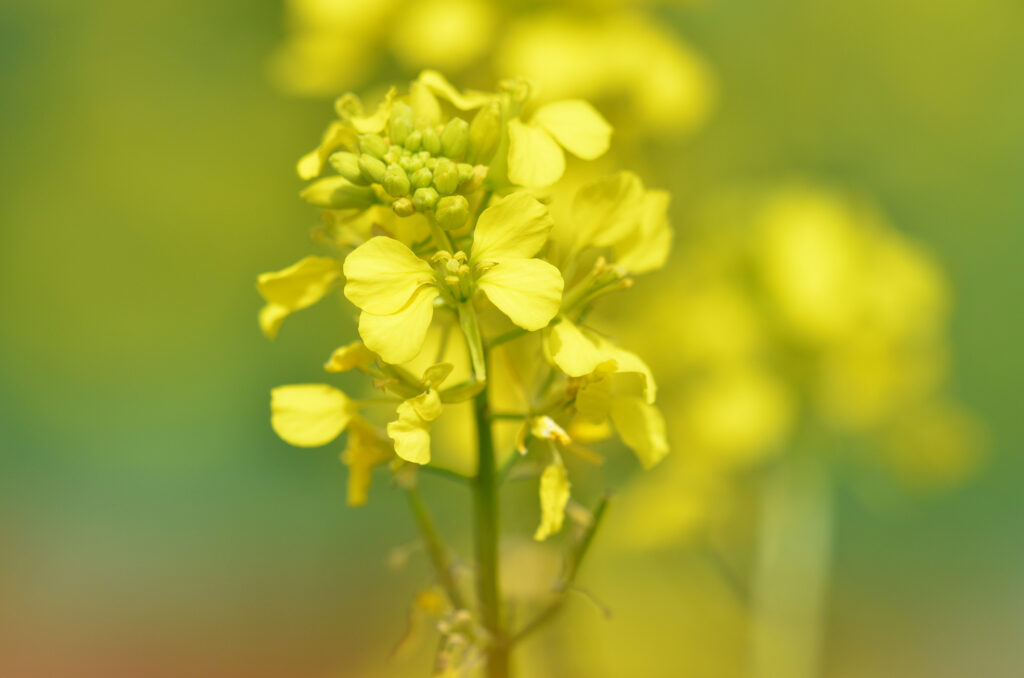As a green manure, mustard has both advantages and disadvantages for agriculture. On the one hand, it's readily available and inexpensive to grow, and helps improve soil quality thanks to its detoxifying properties and ability to fix atmospheric nitrogen. However, excessive use of mustard can have a detrimental allelopathic effect on subsequent crops. It is therefore essential to strike a balance between its benefits and limitations. Mustard as a green manure therefore offers an interesting solution, but requires proper management to maximize its effectiveness.
FREE NATURAL FERTILIZERS AND SOIL IMPROVERS
[arve url="https://www.youtube.com/embed/PvAw79cKoV0″/]
Why plant mustard in the garden?
Mustard is a very versatile plant that can bring many benefits to the garden. First and foremost, mustard is known for its ability to improve soil structure. Indeed, its deep roots decompact the soil and aerate the lower layers, promoting the circulation of air, water and nutrients. What's more, mustard produces a significant amount of organic matter when buried in the soil, helping to increase fertility and humus content.
The presence of mustard in the garden can also help reduce the proliferation of certain weeds. This is because mustard emits chemicals called glucosinolates, which are toxic to many weeds. These substances can inhibit the germination of seeds and the growth of undesirable plants, thus limiting their presence in the garden.
Mustard can also help combat certain crop pests and diseases. Indeed, the presence of mustard in the garden can attract certain species of auxiliary insects, such as ladybugs and hoverflies, which feed on plant parasites. What's more, the glucosinolates produced by mustard may have antifungal properties, which can help reduce the incidence of certain fungal diseases on crops.
In short, sowing mustard in the garden can have many benefits, including improving soil structure, reducing weed proliferation and controlling certain pests and diseases. It's easy to grow, can be used as a green manure or in crop rotation, and offers multiple health benefits for the garden.
How to use mustard as a green manure?
Mustard can be used as a green manure in your garden. Green manuring is the agricultural practice of planting specific crops to improve soil structure, provide nutrients and reduce weeds. Mustard is an excellent plant to use for this purpose.
To use mustard as a green manure, follow these steps:
1. Prepare the floor: Before sowing mustard, make sure the soil is well prepared by weeding and light ploughing if necessary.
2. Choose mustard seeds: There are different types of mustard, so you can choose the one best suited to your region or specific needs. Mustard seeds are generally easy to find in specialized gardening stores.
3. Sow the seeds: Spread the mustard seeds evenly over the prepared soil. You can sow them broadcast or in rows, following the specific instructions on the seed packet.
4. Rake and water : Use a rake to lightly cover the mustard seeds with soil. Water generously to encourage germination.
5. Let it grow : Mustard grows quickly, often in just a few days. Let it grow for about 4 to 6 weeks before incorporating it into the soil.
6. Incorporate into the soil : After 4 to 6 weeks of growth, mow the mustard then incorporate it directly into the soil. This will provide the soil with nutrients and improve its structure.
7. Plant other crops: Once mustard has been incorporated into the soil, you can plant other crops or vegetables in your garden.
Advantages of using mustard as a green manure :
- Thanks to its deep roots, mustard is an excellent plant for improving soil structure.
- It can also reduce weed populations by smothering their growth.
- As it decomposes, mustard releases nutrients such as nitrogen, phosphorus and potassium, which are essential for plant growth.
By using mustard as a green manure, you help improve the health of your soil and promote healthy plant growth. Remember to choose a mustard variety suited to your region and follow the specific instructions for optimal use.
When to cut mustard for green manure?
Mustard is a fast-growing, easy-to-cultivate plant. For use as a green manure, we recommend cutting it before it blooms. In fact, when mustard flowers, it starts to produce seeds that can spread and become a weed. So, to get the best benefits in terms of soil enrichment, it is advisable to cut the mustard when it reaches a height of about 20 to 30 centimetres. This pruning will enable the plant to produce sufficient biomass, while preventing it from growing and multiplying undesirably in your garden.
What are the benefits of mustard?
Mustard is a very popular condiment with many health benefits. Here are just a few of the benefits of mustard:
1. Rich in nutrients : Mustard contains essential vitamins and minerals such as vitamin A, vitamin C, calcium and potassium. These nutrients play an important role in maintaining good health.
2. Antioxidant effect : Mustard is rich in antioxidant compounds such as polyphenols and flavonoids. These antioxidants help neutralize free radicals in the body, protecting cells and reducing the risk of chronic diseases such as cancer and heart disease.
3. Beneficial for the digestive system: Mustard is known to stimulate the appetite and aid digestion. It helps stimulate the production of saliva and gastric juices, making it easier to break down food and absorb nutrients.
4. Anti-inflammatory properties : Some mustard compounds have anti-inflammatory properties that can help relieve joint and muscle pain. Topical application of mustard can also help relieve nasal congestion and headaches.
5. Support for heart health: Studies suggest that regular consumption of mustard may help reduce cholesterol levels and improve heart health, thanks to the omega-3 fatty acids found in mustard seeds.
It should be noted that these benefits are based on preliminary studies and research. As with any food, it is important to consume mustard in moderation and as part of a balanced diet.
Read more : For more information on the benefits of mustard, see our full article on our website.
In conclusion, mustard-based green manures offer numerous ecological advantages. First and foremost, they improve soil structure thanks to their deep roots, which promote aeration and water retention. What's more, mustards are biofumigant plants that naturally combat soil-borne pests and diseases.
HoweverHowever, there are a few disadvantages to using mustard as a green manure. Firstly, some mustard species can be invasive and compete with neighbouring crops if not properly controlled. What's more, they can also release phytotoxic substances into the soil, which can adversely affect other plants.
In conclusionThe use of mustard as a green manure offers many advantages in terms of soil improvement and disease control. However, it is essential to take precautions to avoid the risks associated with its use, such as invasion and phytotoxic effects. Appropriate and careful management of mustard as a green manure is therefore necessary to maximize its benefits while minimizing potential risks.








